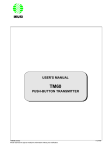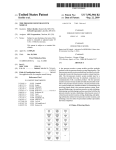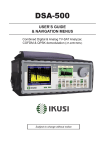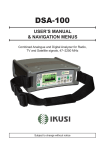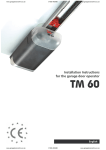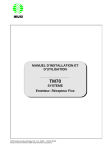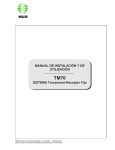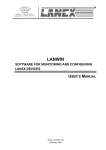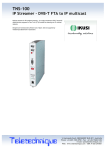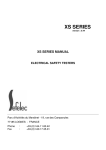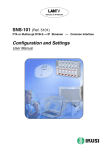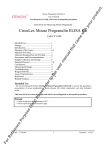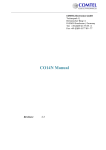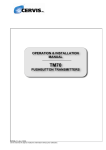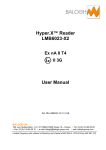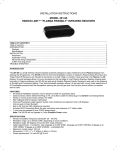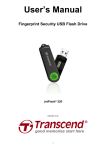Download USER`S MANUAL CONSOLE TRANSMITTER
Transcript
USER'S MANUAL TM60 CONSOLE TRANSMITTER TM60Pi (02/02) IKUSI reserves the right to modify this information without prior notification. 1121049 INDEX Pg. 1.- DESCRIPTION............................................................................................................. 1 2.- SAFETY PRECAUTIONS ............................................................................................ 2 2.1.- What you must do.............................................................................................. 2 2.2.- What you must not do........................................................................................ 2 3.- INSTALLATION............................................................................................................. 3 3.1.- CB60 Battery charger ........................................................................................ 3 3.2.- Receiver ............................................................................................................. 4 3.3.- Starting up .......................................................................................................... 7 3.4.- Spurious ............................................................................................................. 9 4.- USING THE SET .......................................................................................................... 10 5.- MAINTENANCE............................................................................................................ 11 5.1.- Guarantee........................................................................................................... 11 5.2.- Precautions ........................................................................................................ 11 5.3.- Preventive maintenance..................................................................................... 12 5.4.- Identifying faults .................................................................................................. 13 5.5.- Spare parts......................................................................................................... 14 TM60Pi (02/02) PAG. i 1.- DESCRIPTION The TM60/3, TM60/4, TM60/5, TM60/6, TM60/7, and TM60/8 console type transmitter radio remote control systems, are designed for the remote control of hoists and cranes (overhead cranes, tower cranes, hydraulic loader cranes, concrete pumps, driverless vehicles, etc) and are particularly suitable for applications when the operator needs to be able to choose the best location from which to carry out an operation. The system consists of a transmitter for selecting commands and a receiver which is connected to the electrical system of the machine to be operated. The system also comes with a battery charger and two rechargeable batteries. The main specifications are as follows: The TM60 Frequency band Response Time Temperature range 405 a 475 MHz 100 ms -20º a +65ºC The TM60/3, TM60/4, TM60/5, TM60/6, TM60/7, and TM60/8 transmitters Transmission power Protection 10 mW IP65 The R60/9, R60/18, R60/26 and R60/38 receivers Power supply Consumption Relays Protection 48, 115, 230 Vac ± 10%, 50/60 Hz Optional 12 or 24 Vdc 30 to 40 W, depending on models 230 Vac/8 A IP55 The CB60 battery charger Power supply 230 Vac ± 10%, 50 Hz; optional 115 Vac, 60 Hz or 24 Vdc The BT12 batteries Voltage Capacity Charging temperature Autonomy TM60Pi (02/02) 7,2 V 1200 mAh 5º a 35ºC 8 to 12 h, depending on models PAG. 1 2.- SAFETY PRECAUTIONS These instructions must be read carefully in order to install and use the set properly and to keep it in perfect working condition and to reduce the risks of misuse. Do not use this set on machines for the lifting of persons or in potentially explosive atmospheres. Any use other than that specified in this manual is dangerous. The following instructions must be strictly adhered to. Important note: To comply with FCC RF exposure compliance requirements, this device and its antenna must not be co-located or operating in conjunction with any other antenna or transmitter. 2.1.- What you must do: Ø Ø Ø Ø Ø Ø Ø Ø Ø Ø Ø Strictly adhere to the instructions for installation contained in this manual. Make sure that the installation is carried out by professional and competent personnel. Ensure that all site and prevailing safety regulations are fully respected. Make sure that this manual is permanently available to the operator and maintenance personnel. Keep the transmitter out of reach of unauthorised personnel. Remove the transmission key when the set is not in use. On starting each working day, check to make sure that the STOP button and other safety measures are working. When in doubt, press the STOP button. Whenever several sets have been installed, make sure the transmitter you are going to use is the right one. Identify the machine controlled on the label for this purpose on the transmitter. Service the equipment periodically. When carrying out repairs, only use spare parts supplied by IKUSI dealers. 2.2.- What you must not do: Ø Ø Ø Ø Ø Ø Ø TM60Pi (02/02) Never make any changes to the set, which have not been studied and approved by the manufacturer. Never power the equipment other than with the specified power supply. Never allow unqualified personnel to operate the equipment. After use, never leave the equipment ON. Always use the contact key or the STOP button to avoid accidentally activating manoeuvres. Do not use the set when visibility is limited. Avoid knocking or dropping the set. Do not use the set if failure is detected. PAG. 2 3.- INSTALLATION 3.1 The CB60 battery charger Connect the charger to the mains using the power source and cable supplied. On installing the battery charger, bear in mind that the batteries must be charged at temperatures over 5ºC and that the power supply must be left on all night. Also remember that the charger must not be left in direct sunlight as the batteries will not become fully charged at temperatures exceeding 35ºC. Place the batteries in the charger. The LEDs should light up, indicating that recharging is in process. Complete recharging takes 12 hours, but the batteries may remain in the charger for an unlimited period of time. The capacity of the batteries decreases with use. Their life span is estimated to be 500 recharging cycles, but this depends largely on the conditions of use, for which the following is recommended: Ø Ø Ø Ø Ø TM60Pi (02/02) Do not recharge the battery until it is completely flat. The transmitter indicates this. Always charge the batteries at temperatures between 5º and 35ºC. Avoid short-circuits between the battery contacts. Do not carry charged batteries in tool-boxes or next to other metal objects (keys, coins, etc.) Always keep contacts clean. Never leave batteries in direct sunlight. PAG. 3 3.2.- Receiver Make sure that the crane is stopped for the entire duration of the assembly process, keep the work area free and wear protective clothing. Park the crane and position stop-ends, (if these are not available use appropriate signs), at a suitable distance so that it is not hit by other cranes on the same runway. Check the power-supply voltage and turn off the mains switch. Find a suitable location for the receiver, away from any intense radioelectric disturbance source and install the receiver cabinet using 4 elastic absorbers (M8). The receiver antenna must be placed free of shielding by metal parts which could obstruct reception of the signal. If this is not possible, please request an antenna with cable extension. TM60Pi (02/02) PAG. 4 There are three ways to connect the receiver box to the crane's electrical installations: Ø Using multiwire cable. Ø Using a multipin connector in the receiver box. Ø Using a cable with a terminal multipin connector. TM60Pi (02/02) PAG. 5 Connect the power supply and the receiver outputs on the corresponding relay board plug-in terminals. Do this following the outputs diagram, which is supplied with the set. This diagram indicates the connection between the transmitter commands and the receiver outputs. The KSTOP1 and KSTOP2 relays are in series and must be connected to the main contactor coil circuit. The K2/START is activated once the start-up command is held down. The K1/SEC relay is a security relay which is activated when certain commands predefined as “active” on configuration of the set, (i.e. commands which give rise to manoeuvres), are activated. Remember to connect the ground cable. Only use fireproof cables for connections. Select the appropriate voltage on the receiver, (230, 115 or 48 Vac). TM60Pi (02/02) PAG. 6 3.3.- Starting-up Proceed with caution; the equipment may not be connected correctly which may lead to unforeseeable movements on starting-up. Once the receiver has been connected, disconnect the power supply to the motors(for example, by removing the fuses) and power on the receiver. The following receiver LEDs should now light up. POWER: indicates that the power supply is correct. HARD: two LEDs on the relay board and on the logic board indicate the absence of defects on the boards. Next, place a charged battery in the transmitter and turn it ON. To do this, turn the contact key, push and pull out the STOP button and press the start button. The green LED should light up, indicating that the transmitter is transmitting. 1.- LED 2.- Start button 3.- Contact key TM60Pi (02/02) 4.- STOP button 5.- Command elements 6.- Label for crane identification PAG. 7 On receiving a signal from the transmitter, the following LEDs will light up on the receiver: SIGNAL: this indicates that it is receiving an RF signal at the working frequency. DATA: this means that the data format is correct. ID: this means that the receiver has recognised the transmitter’s identification code. Now, the KSTOP 1 and KSTOP 2 relays will be activated. K2/START relay is activated only meanwhile the start button is pushed. Press on any of the transmitter’s manoeuvre buttons and its corresponding relay will be activated and its LED will light up. In case of an active manoeuvre, the safety relay K1/SEC will also activate. Check to make sure all the other manoeuvres work in this way. Turn off the transmitter using the STOP button, and make sure that on doing so the relays are deactivated and the DATA, ID and SIGNAL LEDs go out. Reconnect the power supply to the motors, move to the usual work position and check to see if all the manoeuvres and the STOP buttons are functioning correctly. Remember that the receiver has several voltage-powered circuits. Even when the power has been cut off, there is still a risk of electrical shocks. TM60Pi (02/02) PAG. 8 3.4.- Spurious The receiver is designed to become blocked if there is intense spurious disturbance arising from galvanic, inductive, or capacitive coupling, thus preventing unwanted manoeuvres. As a precautionary measure, it is recommended that spurious-preventing devices (diodes, capacitors, RC circuits) be fitted at the source of the disturbance. These devices should be connected directly to the contactor coil terminals, electro-valves, etc. and can be obtained from the usual contactor suppliers. If the equipment is installed on a vehicle with a friction power supply where electric arcs are produced as a result of defective contact, an RC circuit should be fitted between each phase and earth. Spurious-preventing devices should also be fitted when installing the set on a spark combustion engine vehicle. TM60Pi (02/02) PAG. 9 4.- USE To ensure correct use of the equipment, follow the instructions below: Ø Make sure the transmitter you are going to use is the right one, identifying the machine on the identification label. Ø Attach the belt to the transmitter unit. Its use is recommended to prevent the equipment from falling. Ø Introduce a charged battery, turn the contact key. This will activate the transmitter. Ø To activate the system, you must first pull out the STOP button, the green LED should then give a green pulse; then press the START button. If you find that the STOP button has already been pulled out, it is necessary to push it in and then pull it out again, as this sequence will allow the check in of the STOP circuit. If the unit has experienced a time-out auto-disconnection, it is not necessary to repeat the STOP button procedure, simply push the START button for 1 second. Ø The green LED should light up, indicating that the transmitter has started transmitting. From now on, if any of the transmitter’s command buttons are pressed, the corresponding manoeuvre will be activated. Ø To be able to start up the transmitter, all the command controls associated with active manoeuvres must be in the neutral position (not activated). This is not the case for the selection functions. Ø When 4 minutes have passed and no active manoeuvre command has been activated, the transmitter automatically switches off. To start it up once more, press the start button. Ø The transmitter is equipped with a circuit for monitoring the battery level. When this level drops below a pre-established limit, the transmitter LED starts to flash in red, and a buzzer goes on; 5 minutes later the transmitter switches off, and the machine’s main contactor is deactivated. During this time, the load has to be located on a safe position. Ø The console transmitters have tilt monitoring circuit to detect abnormal console positions. The transmitter cannot work if it is not in the vertical position. If the console is not in a vertical position, the LED will flash red three times and a buzzer will go off. If the console is tilted while transmitting, after 2 seconds all manoeuvres will cease even if the main contactor is still on. To reinitiate transmission, the console must be put back in the upright position and the manoeuvres must be deactivated. Ø To switch off the transmitter, press the STOP button or turn off the contact key. Remember that you are going to remote control a moving piece of machinery. The safety instructions described in chapter 2 of this manual must be strictly adhered to. TM60Pi (02/02) PAG. 10 5.- MAINTENANCE 5.1.- Guarantee IKUSI guarantees the TM60 remote control sets for a period of up to one year after the date of delivery. This guarantee covers repairs and the replacement of defective pieces at our Technical Service Department. Both the transmitter and receiver will be necessary if any repairs or replacements need to be carried out. The guarantee does not cover damage resulting from the following: - transport, incorrect installation, repairs or alterations made to the equipment by personnel other than from IKUSI, obvious misuse or incorrect maintenance of the equipment. Our Technical Service reserves the right to evaluate break-downs and damage. Under no circumstances will IKUSI be held responsible for hold-ups at work, accidents or expenses incurred as a result of equipment malfunctioning. 5.2.- Precautions This equipment is designed for use in an industrial environment. However, we recommend you follow the instructions below to extend the life span of your remote control set: Ø Ø Ø Ø Ø TM60Pi (02/02) Use the belt provided with the transmitter to prevent the transmitter from falling. Do not clean the transmitter with solvents or pressurised water. Use a damp cloth or soft brush. Use and recharge the battery regularly. Check every day that the STOP button is working. Disconnect the receiver cables if soldering/welding work is going to be carried out on the crane. PAG. 11 5.3.- Preventive maintenance A few simple checks can bring to light certain defects which can later be the cause of subsequent break-downs and which can be readily rectified. We recommend the following checks to be made from time to time: Transmitter: Ø Check the transmitter’s closing screws to make sure they are securely tightened. Ø Check the rubber protection seals on the transmitter’s command buttons from time to time. Replace them if they are found to have deteriorated. This will protect the unit’s watertightness. Ø Keep the battery contacts clean. Receiver: Ø Ø Ø Ø Check to make sure the cable fixture screws are tight. Check the contacts on the fuses and the fuse-holders. Check the connectors between the different receiver modules. Check the state of the receiver antenna, its connectors and cables. Battery charger and batteries: Ø Keep all contacts clean. TM60Pi (02/02) PAG. 12 5.4.- Locating Break-downs The transmitter and receiver both have status monitoring LEDs, which help to identify irregularities. The transmitter also has an acoustic buzzer. The most common signals are contained in the tables below: TRANSMITTER LED BUZZER MEANS Green double flashing Solid green Red flashing Red double flashing Off Off Slow single buzz Rapid double buzz Red triplet flashing Solid red Rapid triplet buzz Continuous Transmitter ready for start-up Transmitter transmitting normally Battery level low Transmitter cannot start up because a manoeuvre command button is on. Abnormal console position Transmitter failure RECEIVER In normal circumstances, the 6 green LEDs and the 2 red LEDs (associated with the STOP relays) should be lighting. If this is so, press the transmitter manoeuvre buttons and observe the response of the output relays. If the response is normal, the problem is not related to the remote control equipment and the installation must be checked. If any of the relays is not activated, the problem is associated with the remote control equipment. If this happens, observe the appearance of the LEDs: Relay Board: LED COLOUR ON OFF POWER Green Power supply OK Power failure HARD Green Board OK Failure in the relay or logic board. RELAYS Red Output activated Output not activated HARD Green Board OK Failure in board SIGNAL Green DATA Green Radio signal present Channel free on the channel Message OK Incorrect message ID Green ID Code OK Logic Board: Does not recognise ID Code If the problem is associated with the equipment, please send both the transmitter and the receiver to the your Technical Assistance Service, together with a description of the problem and the status of the LEDs. TM60Pi (02/02) PAG. 13 5.5.- Spare parts BT12 Battery CB60 Battery Charger Power supply for CB60, 230 Vac Power supply for CB60, 230 Vac UK Power supply for CB60, 115 Vac C60C Padded belt B60C padded strap MO60 Optical joystick Optical joystick cover CMO60 Electrical joystick 4x1 Paddle joystick 0-1 Push-button (1c) 0-1 Push-button (2c) Boot for push-button 0-1 Spring return toggle switch (2c) 1-0-1 Spring return toggle switch (2c) 0-1 Maintained toggle switch (1c) 1-0-1 Maintained toggle switch (1c) Boot for toggle switch STOP push-button Contact keylock A60 Receiver antenna PA3 BNC Antenna extension lead Fuse PS60/3 SM Console upper part (customised) PS60/4 SM Console upper part (customised) PI60/3 Console lower part PI60/4 Console lower part Handle 3 Handle 4 TM60Pi (02/02) 2303696 2303685 1106018 1106026 1106027 1175029 1175030 2303668 2303669 1102029 1102061 1102050 1102069 1107006 1102071 1102070 1102049 1102047 1107007 2300146 1102033 1119015 1119020 1105001 2303630 2303635 2303650 2303655 1175022 1175021 PAG. 14
















